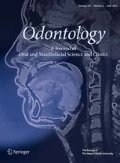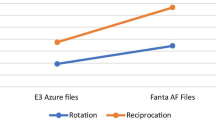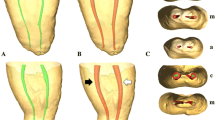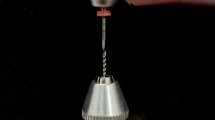Abstract
The aim of the present study was to compare the cutting efficiency of Twisted File instruments used in continuous rotation or TF Adaptive motion and evaluate if prolonged use significantly affected their cutting ability. 20 new NiTi instruments were used in the present study (TF tip size 35, 0.06 taper; Sybron-Endo, Orange, CA, USA), divided into 2 subgroups of 10 instruments each, depending on which movement was selected on the endodontic motor. Group 1: TF instruments were activated using the program TF continuous rotation at 500 rpm and torque set at 2 N; Group 2: TF instruments were activated using the reciprocating TF Adaptive motion. Cutting efficiency was tested in a device developed to test the cutting ability of endodontic instruments. Each instrument cut 10 plastic blocks (10 uses) and the length of the surface cut in a plastic block after 1 min was measured in a computerized program with a precision of 0.1 mm. Maximum penetration depth was calculated after 1 use and after 10 uses, and mean and standard deviation (SD) of each group was calculated. Data were statistically analyzed with a one-way ANOVA test (P < 0.05). TF instruments used in continuous rotation (Group 1) cut a mean depth of 10.4 mm (SD = 0.6 mm) after the first use and 10.1 mm (SD 1.1 mm) after 10 uses, while TF instruments used with the Adaptive motion cut a mean depth of 9.9 mm (SD = 0.7 mm) after the first use and 9.6 mm (SD = 0.9 mm) after 10 uses. There was no statistically significant difference between the two groups investigated (P > 0.05) nor between instruments after 1 or 10 uses. In conclusion, the TFA motion showed a lateral cutting ability similar to continuous rotation and all tested instruments exhibited the same cutting ability after prolonged use.



Similar content being viewed by others
References
Plotino G, Giansiracusa Rubini A, Grande NM, Testarelli L, Gambarini G. Cutting efficiency of Reciproc and WaveOne reciprocating instruments. J Endod. 2014;40:1228–30.
Plotino G, Grande NM, Cordaro M, Testarelli L, Gambarini G. A review on cyclic fatigue testing of nickel–titanium rotary instruments. J Endod. 2009;35:1469–76.
Plotino G, Grande NM, Cotti E, Testarelli L, Gambarini G. Blue treatment enhances cyclic fatigue resistance of Vortex nickel–titanium rotary files. J Endod. (in press).
Plotino G, Testarelli L, Al-Sudani D, Pongione G, Grande NM, Gambarini G. Fatigue resistance of rotary instruments manufactured using different nickel–titanium alloys: a comparative study. Odontology. 2012 [Epub ahead of print].
Peters OA. Current challenges and concepts in the preparation of root canal systems: a review. J Endod. 2004;30:559–67.
Giansiracusa Rubini A, Plotino G, Al-Sudani D, Grande NM, Putorti E, Sannino G, Cotti E, Testarelli L, Gambarini G. A new device to test cutting efficiency of endodontic mechanical instruments. Med Sci Monit. 2014;20:374–8.
Plotino G, Grande NM, Testarelli L, Gambarini G. Cyclic fatigue of Reciproc and WaveOne reciprocating instruments. Int Endodc J. 2012;45:614–8.
Pedullà E, Grande NM, Plotino G, Gambarini G, Rapisarda E. Influence of continuous or reciprocating motion on cyclic fatigue resistance of 4 different nickel–titanium rotary instruments. J Endod. 2013;39:258–61.
Pedullà E, Grande NM, Plotino G, Palermo F, Gambarini G, Rapisarda E. Cyclic fatigue resistance of two reciprocating nickel–titanium instruments after immersion in sodium hypochlorite. Int Endod J. 2013;46:155–9.
Gambarini G, Rubini AG, Al Sudani D, Gergi R, Culla A, De Angelis F, Di Carlo S, Pompa G, Osta N, Testarelli L. Influence of different angles of reciprocation on the cyclic fatigue of nickel–titanium endodontic instruments. J Endod. 2012;38:1408–11.
Gambarini G, Gergi R, Naaman A, Osta N, Al Sudani D. Cyclic fatigue analysis of twisted file rotary NiTi instruments used in reciprocating motion. Int Endod J. 2012;45:802–6.
Fayyad DM, Elhakim Elgendy AA. Cutting efficiency of twisted versus machined nickel–titanium endodontic files. J Endod. 2011;37:1143–6.
Vinothkumar TS, Miglani R, Lakshminarayananan L. Influence of deep dry cryogenic treatment on cutting efficiency and wear resistance of nickel–titanium rotary endodontic instruments. J Endod. 2007;33:1355–8.
Rapisarda E, Bonaccorso A, Tripi TR, et al. The effect of surface treatments of nickel–titanium files on wear and cutting efficiency. Oral Surg Oral Med Oral Pathol Oral Radiol Endod. 2000;89:363–8.
Wan J, Rasimick BJ, Musikant BL, Deutsch AS. Cutting efficiency of 3 different instrument designs used in reciprocation. Oral Surg Oral Med Oral Pathol Oral Radiol Endod. 2010;109:e82–5.
Haikel Y, Serfaty R, Lwin TT, Allemann C. Measurement of the cutting efficiency of endodontic instruments: a new concept. J Endod. 1996;22:651–6.
Schafer E, Oitzinger M. Cutting efficiency of five different types of rotary nickel–titanium instruments. J Endod. 2008;34:198–200.
Schafer E, Erler M, Dammaschke T. Comparative study on the shaping ability and cleaning efficiency of rotary Mtwo instruments. Part 1. Shaping ability in simulated curved canals. Int Endod J. 2006;39:196–202.
Burklein S, Benten S, Schäfer E. Shaping ability of different single-file systems in severely curved root canals of extracted teeth. Int Endod J. 2013;46:590–7.
Kim JW, Griggs JA, Regan JD, et al. Effect of cryogenic treatment on nickel-titanium endodontic instruments. Int Endod J. 2005;38:364–71.
Shen Y, Haapasalo M. Three-dimensional analysis of cutting behavior of nickel–titanium rotary instruments by microcomputed tomography. J Endod. 2008;34:606–10.
Machian GR, Peters DD, Lorton L. The comparative efficiency of four types of endodontic instruments. J Endod. 1982;8:392–402.
Peng B, Shen Y, Cheung GS, Xia TJ. Defects in ProTaper S1 instruments after clinical use: longitudinal examination. Int Endod J. 2005;38:550–7.
Yamazaki-Arasaki A, Cabrales R, Santos Md, Kleine B, Prokopowitsch I. Topography of four different endodontic rotary systems, before and after being used for the 12th time. Microsc Res Tech. 2012;75:97–102.
Arantes WB, da Silva CM, Lage-Marques JL, Habitante S, da Rosa LC, de Medeiros JM. SEM analysis of defects and wear on Ni–Ti rotary instruments. Scanning. 2014. doi:10.1002/sca.21134.
Peters OA, Morgental RD, Schulze KA, Paquè F, Kopper PM, Vier-Pelisser FV. Determining cutting efficiency of nickel–titanium coronal flaring instruments used in lateral action. Int Endod J. 2014;47:505–13.
Conflict of Interest
The authors declare that they have no conflict of interest.
Author information
Authors and Affiliations
Corresponding author
Rights and permissions
About this article
Cite this article
Gambarini, G., Giansiracusa Rubini, A., Sannino, G. et al. Cutting efficiency of nickel–titanium rotary and reciprocating instruments after prolonged use. Odontology 104, 77–81 (2016). https://doi.org/10.1007/s10266-014-0183-0
Received:
Accepted:
Published:
Issue Date:
DOI: https://doi.org/10.1007/s10266-014-0183-0




